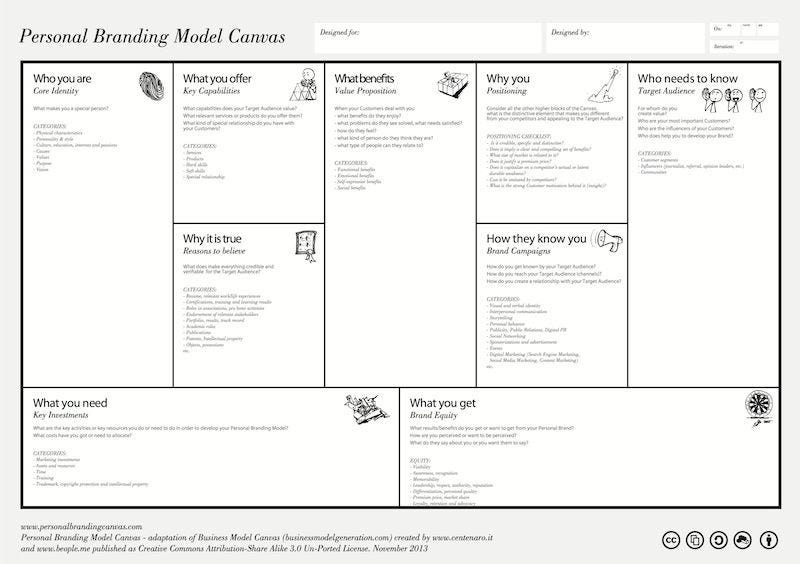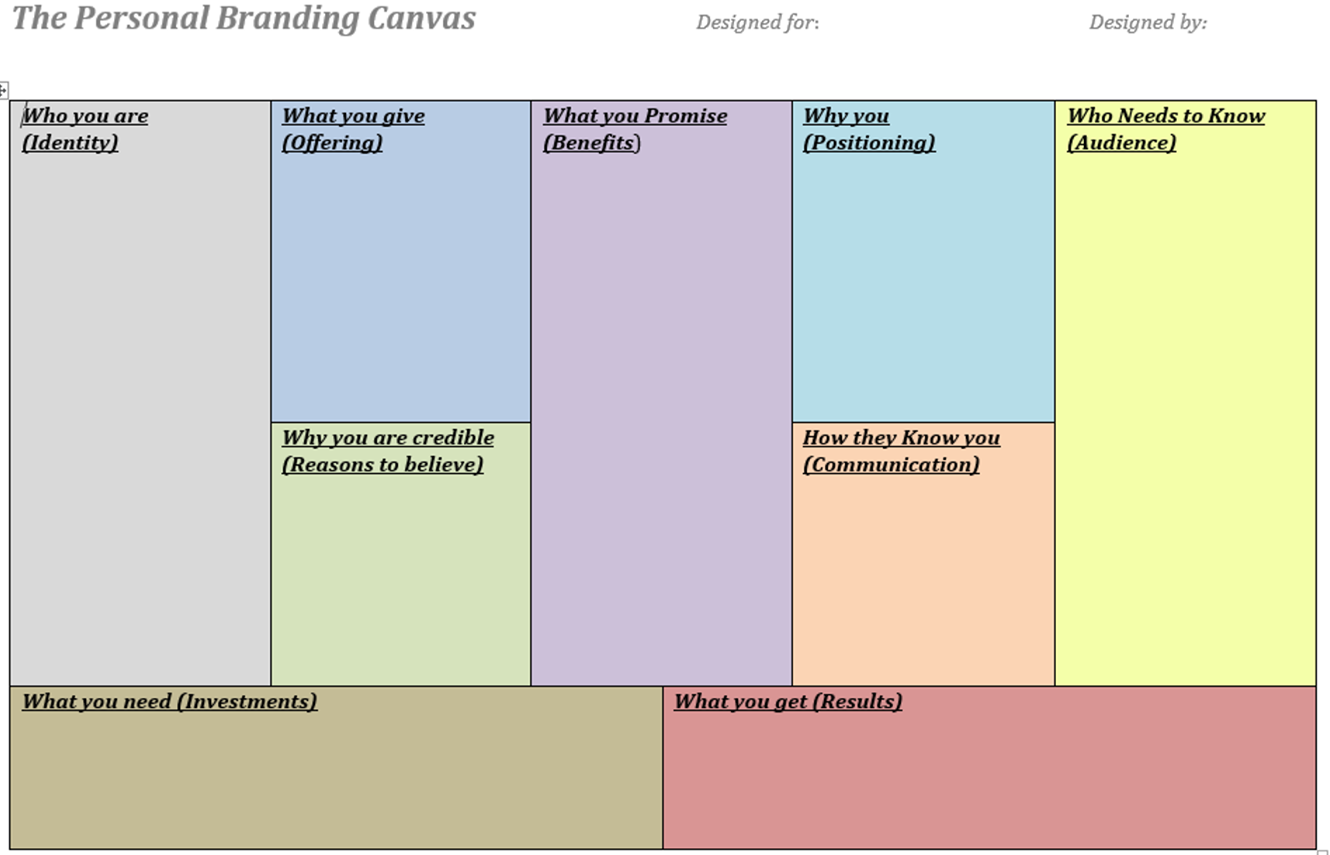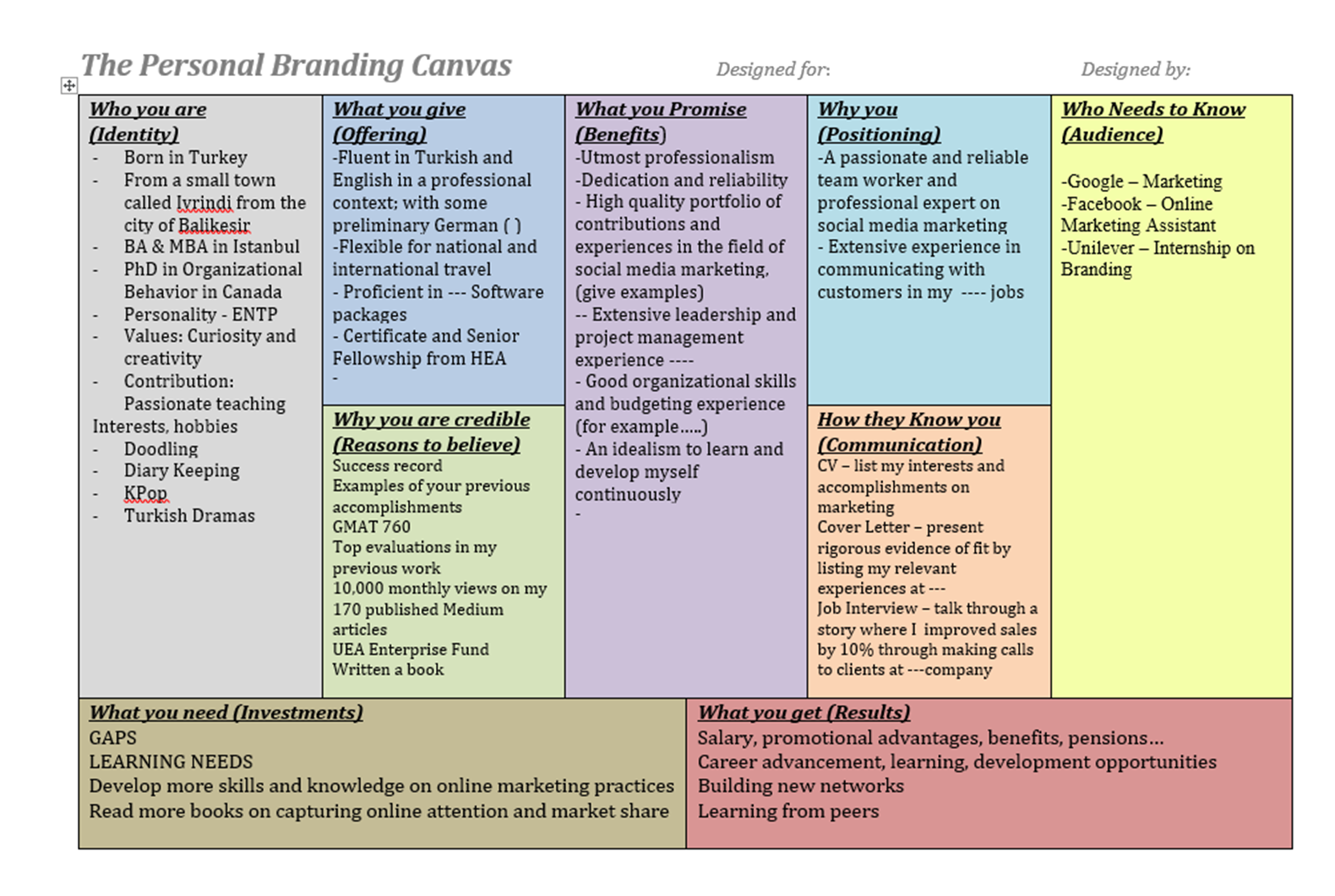Brand Canvas Template
How to Create Your Personal Branding Canvas
And why it matters
As I teach my course titled "Employability, Creativity, and Personal Development" module at the University of East Anglia, one of the seminar exercises I want my students to complete is the Personal Branding Canvas. I believe personal branding has become one of the key requirements and differentiators for young individuals who are entering the job market.
What comes up when you Google yourself? This is your Google Quotient, and it has become a key part of your personal brand. Whenever you have a job interview, your recruiters will Google you and check your social media profiles. Your LinkedIn page is thus another indicator of your online professional presence. It is your job to design and build your online personal presence so that it best reflects your personal brand. For example, this is how Bill Gates introduces his web page:
"I'm lucky enough to get to work with great people and focus on some of the toughest problems the world faces. Things like developing low-carbon and cheap energy sources, improving global health for the world's poorest, and working to find the best ways to improve our education system. I'll share notes on Facebook about great organizations, ideas, and events that are helping us make progress. Join us to get involved, learn more, or add your thoughts and perspectives. Thanks for stopping by."
As you can see, this statement is short, focused, clear, and conversational. It welcomes readers, emphasizes wicked problems, and builds a personal connection with them. It is a good reflection of the personal brand of Bill Gates. "Inside Bill's Brain" is another documentary delving into the life, goals, and passions of this iconic entrepreneur. This documentary is also a powerful statement — a perfect extension of the personal brand of Bill Gates:
Of course, personal branding is so much more than just online presence. Your personal brand also involves what people think about you and how they talk about you when you are not present. It is the unique combination of talents, strengths, skills, values, and experiences that make you who you are. As the gig economy keeps growing and makes up almost half of all the workforce, the average employee switches jobs almost every year. That is why you will need to provide ample evidence on how you can contribute to the organization(s) that you are applying for. What makes you tick? What do you stand for? Why do you get out of bed every morning? What are you passionate about? What brings you joy? How will you get better in your field? Your responses to these questions will largely shape your personal brand.
Your personal brand should reflect your unique strengths, talents, and authenticity. Think of Richard Branson's personal brand: He exemplifies craziness, wild experimentation, adventure, risk-taking, and entertainment. His values and personality shine all over Virgin companies.
To establish a strong personal brand, you need to invest in yourself and establish a long-term strategy to become a good practitioner, thought leader, and expert in your field. You will gain trust, recognition, and respect as a result of your long-term commitment to learning, development, and experimentation in your field(s). Think about Oprah — she has inspired millions of people in their journey of discovering their own potential. She has done this consistently over two decades and she has always offered positive messages for the mind and for the soul.
As we have established the significance of personal branding for your life and career, let's now introduce the personal branding canvas.
Personal Branding Canvas
Personal Branding Canvas was created by Luigi Centenaro to help individuals to systematically think about their personal brand and improve it.
Centenaro was inspired by Tim Clark's and Alex Osterwalder's work on Business Model Canvas and he created the Personal Branding Canvas to help individuals better position themselves in the market.
The good thing about this tool is that it is very holistic and visual — you can create and map out all your personal branding elements on just one page. It is very practical and user-friendly as it gives you a strategic overview of how you can best position yourself, your skills, and your knowledge in the job market.
Personal Branding Canvas is comprised of nine blocks:
- Who you are (Core identity)
- What you offer (Key capabilities)
- Why you are credible (Reasons to believe)
- What benefits you provide (Value proposition)
- Why you (Positioning)
- How they know you (Communication)
- Who needs to know (Target audience)
- What you need (Key investments), and
- What you get (Results).
As you map out and build these nine blocks, you are essentially building and improving your personal brand.

Exercise: Create Your Personal Branding Canvas
This exercise will take about half an hour to complete. Please create your branding canvas now. Let's go over these nine blocks one by one so that you can complete each box.
Please feel free to put your responses in bullet points. Try to write down quickly without thinking too much.

We first start with the part of the canvas that is about your audience (the receivers of your message).
1. Who Needs To Know? (Audience)
In this section, please think about who your audience will be. In my class, I ask my students to identify the companies they will be applying for. These companies and departments will be the audience of this exercise, as students will aim to improve their employability through their personal branding. If you want to increase your employability, you can put your recruiters here. If you want to convey your personal brand to your clients, you can think about your customers and communities for whom you are creating value.
2. Why You: (Positioning)
In this box, think about why these companies should hire you instead of others. What makes you a compelling candidate (or business partner)? What sets you apart from the competition? Make a list of the distinctive elements that make you different from others.
3) What Benefits You Provide: (Key Benefits)
In this section, please make a list of all the benefits you can provide for the companies that you work for. How can you add value? What do you bring to the table? What benefits can your customers enjoy? Describe the contributions you can make to the company if they hire you. It is a good idea to present evidence that illustrates your employable skills and knowledge in this section.
4) How They Know You: (Communication)
How will your clients or companies reach you? How will they know you and what you can offer? In this box, I encourage my students to think about all the stages of their job application and how they can best communicate their strengths to their employers. For example, how can you best represent your relevant skills and knowledge on your CV? How can you present evidence about your professional experiences on your cover letter that matches the job requirements? How can you talk through your most compelling stories and experiences during the job interview?
We then continue with the parts of the personal branding canvas that describe who you are.
5) Who You Are: (Core Identity)
In this section, you will first reflect on your personal history, hometown, background, family, education, and city. Where do you come from? What is unique about you? What makes you a special person? You will then continue with your personality, values, and passion. What do you stand for? What do you want to achieve? What are your biggest goals and ambitions? What do you feel proud of? You can also share your interests and hobbies here — but make sure they are focused and specific.
6) What You Do: (Offering)
In this part, you can present what you offer to your customers. What are your key products and services? How do you provide value? How do you create value for the companies you work for? In this section, I encourage students to think about all the qualifications, technical skills, and special knowledge they can offer to the companies hiring them. These might include having a driving license, being able to travel, speaking particular languages, coding, creating a web site, or using a software.
7) Why You Are Credible: (Reasons to believe)
In this section, you can reflect on your success record and accomplishments until now. What makes you credible? How can your audience trust you? What were your accomplishments and contributions as of date? Are there any sample projects that you have already completed? Do you have any certificates or distinctions? Please make a list of all these.
8) ROI (Return on Investment) section
In this part, you can visualize how you would benefit from your personal branding efforts if you reach all your goals. What would be some of the benefits you would get? How do you define your own success? Will you attain visibility, sales, market share, or new networks? In this part, I encourage my students to make a list of all the benefits and results that they would get if they were recruited. Salary, pension, other benefits, job security, career advancement opportunities, learning, development, support networks, recognition, promotion, etc.
9) What You Need: (Key Investments)
In this section, you will need to make a list of all the things that you need to do in order to invest in your personal brand. How will you invest in yourself? How will you keep learning and reading? Which skills and knowledge will you develop? What types of courses will you take? I suggest my students make a list of all the actions they need to complete in order to improve their employability and get their dream job.
You can see a sample Personal Branding Canvas that I prepared today during my seminar teaching. I just improvised and typed up these bullet points to provide a baseline and guide for my students to come up with their own version. The focus here was on employability.

Additional Canvas Options
If you consider yourself an entrepreneur, you can also complete a business-focused version of this canvas. This version is called "Personal Business Model Canvas" and it is much more similar to the classic business model canvas. You can complete this version if your main focus is on developing your entrepreneurship and business rather than developing your employability.
Source: https://medium.datadriveninvestor.com/how-to-create-your-personal-branding-canvas-b1ffa5252e59


0 Komentar